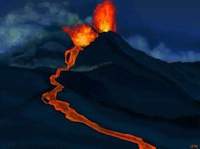Next eruption of Vesuvius may kill hundreds of thousands of people
The next eruption of Vesuvius may kill at least 300,000 people, nearly 20 times as many as the disaster that buried the ancient cities of Pompeii, Herculaneum and Stabia in AD 79, according to a recent study commissioned by the Italian government. The findings of the research were released by mignews.com which stresses the point that data had been gathered and analyzed by a team of Italy’s leading vulcanologists and public health experts in collaboration with Peter Baxter of Cambridge University.

Dr. Baxter is otherwise known as “Dr. Doom” for his studies of the victims of eruptions. “High temperatures would be the main cause of death. “At the final stage of an eruption the flows would penetrate windows, burn people to death or asphyxiate them,” Dr. Baxter said.
One of the main reasons why the scenario of a potential eruption looks so ominous is that Vesuvius, known as “hell’s chimney pot” in the Middle Ages, has not erupted for more than sixty years. Over the past 2000 years, the volcano erupted once a year on the average.
Eight minor eruptions of Vesuvius took place over a period of time that followed the Pompeii disaster in AD 79 and ended in the 17th century with a major eruption in 1631 when the entire surrounding area was engulfed by the flows of lava. Several villages were destroyed by the eruption. The next major eruption occurred in 1794. The volcano’s large-scale eruptions are dubbed Plinian after Pliny the Younger who witnessed the Pompeii disaster and later described it in a letter to Tacitus: “Darkness fell – not the dark of a moonless or cloudy night but as if the lamp had been put out in a closed room.” The tops of the mountains are usually destroyed and millions of tons of ash and lapilli (pieces of lava) are spewed into the sky in the course of a major eruption.
Perhaps the picture is not as black as painted. “The attempts aimed at making a specific local forecast of eruptions often end in failure,” emphasized Alexander Portnov, doctor of geology and mineralogy, professor of the Moscow University of Geological Exploration, in an interview to Nezavisimaya Gazeta. “However, it will be a different story if scientists can make use of some data to forecast earthquakes. For instance, the Japanese use laser equipment for monitoring minutest movements of the earth’s crust. The equipment is capable of recording a shift that measures just a few centimeters. The movements indicate an increase in the pressure of gases and lava underneath the crust. The Japanese would apply a certain gradient – an amount of time required for an elevation to be complete – to their analysis of data, and thus make a rather accurate forecast of eruptions. If the monitoring of Vesuvius is carried out using similar equipment, all these alarming data should be given most serious consideration. However, I have my doubts that a major eruption is in the wings if those predictions are based solely on some rumbling and jolting reported on site,” Dr. Panov said.
Needless to say, the estimated death toll – about 300,000 people – is just a forecast. It is true that more than half a million people live in the so-called “red zone” within a 4 mile radius of the volcano. Most of the residents would die if an evacuation could not be completed in time, the research says.
“Tens of thousands living in the area surrounding Mount Kilimanjaro will probably die if the volcano starts spitting lava and ash. Likewise, the eruption of Etna, Vesuvius or any other volcano could result in similar consequences. Our planet has plenty of volcanoes which may wake up someday. Speaking of Vesuvius, we should not forget that areas around it are densely populated; many people live in the lower slopes of the mountain and on the plains at its foot.
The volcanic soil is very fertile because a volcano throws out lava that has high potassium content. That is why the area around Vesuvius is famous for its vineyards of wine grapes,” Dr. Portnov said.
It is worthy of note that the estimated death toll refers to a potential number of victims of an possible eruption of Vesuvius, which has not erupted since 1944. By all appearances, the Italian government research contains no data whatsoever with reference to the volcano’s activity recorded after the eruption of 1944. Herculaneum was last covered in a thick layer of volcanic ash in AD 79. There is a huge gap in terms of time between the two events. What may have caused the changes in the activity of such a longstanding and somewhat poeticized volcano as Vesuvius?
“The phenomenon has to do with the turning of the entire continent, namely, Africa.
A great deal of pressure is put on the seafloor of the Mediterranean in the process. Africa is moving clockwise, but it’s moving at a snail’s pace so the compression zone, Gibraltar, has not been broken yet. We can be positive now that the Red Sea rift burst open. A rift zone is a system of related, narrow structural depressions between parallel faults. It will result in a fault that in turn will create a splaying fracture,” Dr. Portnov said.
Nezavisimaya Gazeta
Translated by Guerman Grachev
Pravda.ru
Subscribe to Pravda.Ru Telegram channel, Facebook, RSS!




